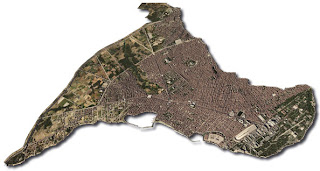 |
| Panaromic view of Byzantion [1] |
According
to Roman historian Pliny the Elder, the city of Lygos was founded in 13th
Century BC as a Thracian colony. It was a promissing city; it lied at the
juncture of two seas, on some of the important trade routes of the Ancient
world. However, like many others, it was destoryed by the Aegean Migrations and
the Bronze Age Collapse swallowed this Thracian colony, too... In 600 years, a
group of colonists under the leadership of Byzas of Megara, a city in the
vincinity of Athens, sailed up to the Seraglio Point of Istanbul, where Lygos
was once, and founded a city of their of own in its place in 657 BC under the
name “Byzantion”.
According
to legend, Byzas consulted the Oracle of Delphi before founding his city. The
Oracle decreed that he should found it “opposite the blind”. Confused as he
made no sense out of it until he reached to the shores of the Bosphorus, and
saw the city of Chalcedon on the Asian side. Chalcedon (present Kadıköy) was
located a few kilometers away from the superior location that was once Lygos,
and suprised by it as they did not found their city on that spot. And
therefore, he founded his city on the “opposite of the blind.”
 |
| Map of Constantinople [2] |
The city suffered extensive damage for the
second time during a power struggle between Emperor Constantine I and his
co-Emperor and rival Licinius. Constantine’s projects in Byzantion were not
limited to restorations. Expanding and renaming it New Rome (Nea Roma, May 11,
330), he also decided to make it his Empire’s capital. That name, however,
didn’t last long, and people began to call it Constantinople. The first Hagia
Sophia Church (present structure is the third) was also built during his reign.
 |
| Süleymaniye Mosque, Ottoman Era, Istanbul [3] |
As the Ottoman Empire came to end and the
Republic was declared, Istanbul became a reflection of modern Turkey. Being the
most cosmopolitan city of the Middle East and the Balkans and a very attractive
financial center, Istanbul is now housing Lygos once again… a LYGOS that is aiming to shape
the future!
[1] (http://www.arkeo3d.com/byzantium1200)
[2] (http://www.arkeo3d.com/byzantium1200)
[3] (en.wikipedia.org/wiki/Suleymaniye_Mosque)
[4] (http://www.worldturkey.com/gallery/data/media/71/levent010.jpg)
 |
| Levent District, Istanbul [4] |
[2] (http://www.arkeo3d.com/byzantium1200)
[3] (en.wikipedia.org/wiki/Suleymaniye_Mosque)
[4] (http://www.worldturkey.com/gallery/data/media/71/levent010.jpg)

No comments:
Post a Comment